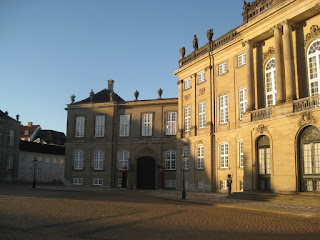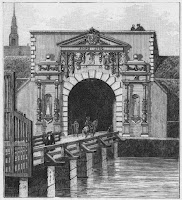Large portions of this area were destroyed during the two great fires in 1728 and 1794 and by the the British bombardment of the city in 1807. As a result, nearly the entire district was rebuilt during the 18th century and early 19th century. The rapid replacement of such a large portion of the city’s building stock allowed a specific type of building to proliferate, with common features and proportions.
Study Block
Streets
The study block for this neighborhood is located between Brolæggerstræde (NW), Knabrostræde (SW), Kompagnistræde (SE) and Badstuestræde (NE) streets. These streets all have rights of way of about 8 meters. Brolæggerstræde, Knabrostræde and Badstuestræde are paved with asphalt and have sidewalks on either side that area about 1.5 meters wide, leaving about 5 meters for vehicles. Kompagnistræde is paved with cobblestones and concrete blocks and has no sidewalks, although changes in paving material indicate a vehicular travel-way of about 4 meters. Kompagnistræde is technically part of the Strædet pedestrian street, though there are no physical barriers to cars entering from adjacent streets.
Automobile and bicycle parking occupies one side each of Brolæggerstræde, Knabrostræde and Badstuestræde.
Block
The study block forms an irregular quadrangle with a total surface area of about 3,700 m2 or about 0.91 acres. It’s sides are 50, 70, 60, and 66 meters long (NW, SW, SE, NE) for a total perimeter of 246 meters. Building frontage along the perimeter is continuous. There are 14 street-fronting buildings on the block, 5 interior buildings, and 8 courtyards.
Parcels
The cadastral layout of the study block has changed relatively little since the development of the existing building stock at the end of the 18th century. A cadastral map from 1761 map shows parcels of highly irregular size and shape, all of which however include street frontage and a back area for a courtyard and backbuildings or wings. As of 1761 there remain two gaps in the streetwall along Knabrostræde and a total of 14 parcels.
The cadastral map from 1807, thirteen years after the Great Fire of 1794, shows a partial transformation of the block, with most of the building footprints slightly altered and several minor changes to parcel boundaries. The cadaster maps show no change in the study block from 1807 to 1861, with a total of 13 parcels present. Since 1861 several parcels have been combined, dropping the total parcel count down to 10. The two instances of parcel combination (on the SW side of the block) have occurred around shared courtyards, suggesting it is more advantageous to consolidate parcels where buildings make use of common entrances and open space.
1760 1861 2016
Buildings
At present there are 19 buildings on this block, all built between 1700 and 1799. More than half were built in the late 1790s after the Great Fire of 1794. They are fairly consistent in scale and style, the main outlier being 18 Badstuestræde, which is significantly larger and has a more ornate facade than others on this block. It is also the only building to fully enclose a courtyard. Almost all of the buildings on this block feature ground-level retail uses, and many of the former dwelling units have been rented out as offices. All represent some permutation of the “Golden Era Apartment House” type delineated below.
Density
At present the block contains approximately 115 units, however according to government records, only 68 units are used for housing. With a block area of 3,700m2 this yields a density of 184 dwelling units (DU) per hectare or 74 DU per acre. The current average household size in Denmark is 1.7 [cite] leading us to an estimate of 129 residents per acre.
We can be sure that this number was higher in the past. With all 115 units occupied at least part time as residences, the block’s density would have been 125 DU/acre. If we take the average household size (4.2) in Soren Kierkegaard’s similar apartment house as normal, we get a block population of 483, or 525 per acre.
It is reasonable to think that a certain number of the units not listed as residences are used as AirBnB or other short term rentals, indicating that the current density may be higher than indicated by government figures.We can be sure that this number was higher in the past. With all 115 units occupied at least part time as residences, the block’s density would have been 125 DU/acre. If we take the average household size (4.2) in Soren Kierkegaard’s similar apartment house as normal, we get a block population of 483, or 525 per acre.
Rents/Valuation
Three flats are currently for sale on the study block. Their asking prices are $700,000 (Badstuestræde 16), $825,000 (Badstuestræde 18D) and $1.6 million (14 Kompagnistræde). Respectively these units are 97m2, 136m2 and 179m2 in size, giving us valuations of $7,220 per m2, $6,066 per m2 and $8,940 per m2.
Traffic
A traffic count conducted during morning rush hour on Kompagnistræde observed 166 passersby. About 72% of these were on bicycle, 23% on foot, and the remainder in vehicles. About 10% of the passersby entered or left from one of the buildings on this part of Kompagnistræde (including the opposite block). Of the cyclists, a slim majority were female; of the walkers a slim majority were male; and all of the passersby in vehicles (9 people in 7 vehicles) were men. Only one child passed by during the observation period.
A traffic count conducted during morning rush hour on Kompagnistræde observed 166 passersby. About 72% of these were on bicycle, 23% on foot, and the remainder in vehicles. About 10% of the passersby entered or left from one of the buildings on this part of Kompagnistræde (including the opposite block). Of the cyclists, a slim majority were female; of the walkers a slim majority were male; and all of the passersby in vehicles (9 people in 7 vehicles) were men. Only one child passed by during the observation period.











































